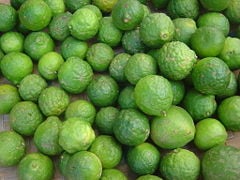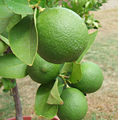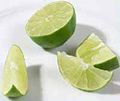| Lime | ||||||||||||||
|---|---|---|---|---|---|---|---|---|---|---|---|---|---|---|
 Kaffir Lime fruit
| ||||||||||||||
| Scientific classification | ||||||||||||||
|
Lime is a term referring to a number of different species and hybrids of shrublike trees of the genus Citrus, as well as the name for the popular edible fruit of these plants. Lime plants are characterized by a spiny or thorny stem, green and leatherly leaves, and clusters of small and aromatic white flowers. The fruit, which is similar to the lemon, is juicy, oval (egg-shaped), small (3-6 centimeters in diameter), acidic, and typically green or yellowish green even when mature (but will turn yellow like the lemon if exposed to a cool winter environmental conditions). The lime fruit tends to be smaller and rounder (globular) than the lemon, and with a sweeter and more acidic pulp and a thinner rind.
The Citrus genus is a group of flowering plants in the family Rutaceae (orange family) that originated in tropical and subtropical southeast Asia and that have a distinctive berry with the internal parts divided into segments. Besides limes and lemons, other members of the Citrus genus include oranges, citrons, grapefruit, pomelos (pummelo, pommelo), and mandarins (tangerines). Most members of the Citrus genus arose as hybrids, and the hybridized types of citrus may or may not be recognized as species according to different taxonomies (Katz and Weaver 2003).
The fruit of the lime serves the plant's individual purpose of reproduction while also providing a number of values for human beings. Like the lemon, the lime is used for such culinary purposes as being diluted and sweetened and made into a drink, being used as a garnish for drinks, and used for flavoring for desserts, condiments, salad dressings, meats, and vegetables. The extracts and essential oils are used in cleaning products and perfumes, among other uses.
Overview and varieties
Katz and Weaver (2003) claim that the generally accepted view is that there were three primordial Citrus species—Citrus medica (citrons), Citrus maxima (pumelos), and Citrus reticulata (mandarins)—and that all other types of citrus rose from single or sequential hybridization events between these species or their offspring. Other possible original species could be Citrus aurantifolia, the key lime, from India, and Citrus halimii, a more recent discovery, from Thailand and Malaysia. Based on whether the hybridized types of citrus are recognized as species, anywhere from three to 170 species are recognized, with the commonly used system of Swingle recognizing 16 species (Katz and Weaver 2003).
Plants designated as limes include both species, such as Citrus aurantifolia (key lime), and a variety of hybrids, with major ones being Citrus x limonia (Rangur lime) and Citrus x latifolia (Persian lime, a cross between true lime and citron).
The limes most commonly available commercially are the smaller, yellower key lime and the larger, greener Persian lime. "Key lime" is an American retronym, as the original fruit known in English as a "lime" was Citrus aurantifolia, derived from the Persian name لیمو, limu (the fruit was introduced to Europe during the Crusades). Other limes include the Mandarin lime (Citrus limonia), Kaffir lime (Citrus hystrix), the various Australian limes, sweet lime (Citrus limetta), and Palestine sweet lime (Citrus limettioides).
The name lime is also used for some species that are not part of the Citrus genus, such as Spanish lime (Melicoccus bijugatus), wild lime (Adelia ricinella), and musk lime ((X Citrofortunella mitis). The limequat is a lime-kumquat hybrid.
The color of citrus fruits only develops in climates with a (diurnal) cool winter. In tropical regions with no winter, citrus fruits remain green until maturity, hence the tropical "green orange." The lime plant, in particular, is extremely sensitive to cool conditions; thus, it is usually never exposed to cool enough conditions to develop a color. If they are left in a cool place over winter, the fruits actually will change to a yellow color.
For cooler winter areas, lemon and lime trees should not be grown, since they are more sensitive to winter cold than other citrus fruits.
According to the Food and Agriculture Organization (FAO), Mexico produced almost 12 percent of the global output of lemons and limes in 2005 followed by India, Argentina, Iran, and Brazil.
Uses
Astringent citrus, such as limes and lemons, are generally not eaten on their own. Both limes and lemons are regularly served as limeade or lemonade by diluting the juices of these fruits and adding sugar. Lemons and limes are also used as garnishes for drinks such as iced tea or a soft drink, with a thin slice of the fruit or corkscrew strip of the peel (twist). Alcoholic beverages prepared with limes include cocktails such as gin and tonic, margarita, mojito, and Cuba libre. One customary consumption of tequila is in shots accompanied by lime wedges and salt. Beer is often served with limes in Mexico, as well as some other countries. Lime juice is also used in commercial soft drinks.
Lemons and limes are used as an ingredient in a variety of dishes and their juice can commonly be found in salad dressings and squeezed over cooked meat or vegetables. In cooking, lime is valued both for the acidity of its juice and the floral aroma of its zest (the outer, colorful skin of citrus fruit). It is used in tacos, key lime pie (a traditional Florida dessert), and is a very common ingredient in authentic Mexican and Southwestern American dishes. It is also used for its pickling properties in ceviche. Additionally, the leaves of the Kaffir lime are used in southeast Asian cuisine. The use of dried limes as a flavoring is typical of Persian cuisine and the soft drink Sprite.
In order to prevent scurvy during the nineteenth century, British sailors were issued a daily allowance of citrus such as lime (presumably Citrus aurantifolia), which led in time to the nickname "limey" for all Britons. It was later discovered that this beneficial effect derived from the quantities of vitamin C the fruit contains.
Lime extracts and essential oils are frequently used in perfumes, cleaning products, and aromatherapy.
Fruits known as "lime"
- Australian limes
- Australian desert lime (Citrus glauca)
- Australian finger lime (Citrus australasica)
- Australian round lime (Citrus australis)
- Blood lime
- Kaffir lime (Citrus hystrix) (a.k.a. kieffer lime; makrut, or magrood)
- Key lime (Citrus aurantifolia) (a.k.a. Mexican, West Indian, or Bartender's lime)
- Mandarin lime (Citrus limonia)
- Musk lime (X Citrofortunella mitis)
- Palestine sweet lime (Citrus limettioides)
- Persian lime (Citrus x latifolia) (a.k.a. Tahiti or Bearss lime)
- Spanish lime (Melicoccus bijugatus) (a.k.a. mamoncillo, mamón, ginep, quenepa, or limoncillo) (not a citrus)
- Sweet lime (Citrus limetta) (a.k.a. sweet limetta, Mediterranean sweet lemon)
- Wild lime (Adelia ricinella)
- Limequat (lime × kumquat)
Gallery
ReferencesISBN links support NWE through referral fees
- Department of Horticulture and Landscape Architecture, Purdue University. 2007. Lecture 32: Citrus. Retrieved May 20, 2007.
- Ehler, J. T., and FoodReference.com. 2007. Key Limes (Citrus aurantifolia). Retrieved May 20, 2007.
- Herbst, S. T. 2001. The New Food Lover's Companion: Comprehensive Definitions of Nearly 6,000 Food, Drink, and Culinary Terms. Barron's Cooking Guide. Hauppauge, NY: Barron's Educational Series. ISBN 0764112589
- Katz, S. H., and W. W. Weaver. 2003. Encyclopedia of Food and Culture. New York: Schribner. ISBN 0684805685
- Morton, J. F., and C. F. Dowling. 1987. Fruits of Warm Climates. Miami, FL: J. F. Morton. ISBN 0961018410
Credits
New World Encyclopedia writers and editors rewrote and completed the Wikipedia article in accordance with New World Encyclopedia standards. This article abides by terms of the Creative Commons CC-by-sa 3.0 License (CC-by-sa), which may be used and disseminated with proper attribution. Credit is due under the terms of this license that can reference both the New World Encyclopedia contributors and the selfless volunteer contributors of the Wikimedia Foundation. To cite this article click here for a list of acceptable citing formats.The history of earlier contributions by wikipedians is accessible to researchers here:
The history of this article since it was imported to New World Encyclopedia:
Note: Some restrictions may apply to use of individual images which are separately licensed.



